A Fault Diagnosis Method for Analog Circuits Based on Improved TQWT and Inception Model
Abstract
:1. Introduction
- This paper proposes integrating the improved TQWT together with the Inception model for multi-band and multiscale feature extraction to obtain the weak features of analog circuit fault signals.
- The Q-factor of the TQWT is quantized by utilizing GWO with a high capability of global optimization. The inverse TQWT is utilized along with the RMSE of the initial signal as an evaluation criterion to determine the optimal Qfactor. The optimum quality factor Q is used to decompose the signal for the TQWT and the multi-band signal is obtained via single-branch reconstruction to capture the local detail features of the signal. This optimization enables the TQWT to be more compatible with the signal characteristics and to extract more detailed features.
- The Inception model performs feature extraction on multi-band signals and multiscale feature extraction based on band differentiation, refining the features while avoiding the parameter redundancy of traditional CNNs.
2. Materials and Methods
- (1)
- Collect the impulse response signals at the output points of the test circuits and obtain the complete initial data set via Monte Carlo analysis. The data set is divided into a training set and a test set;
- (2)
- Use the training set data to optimize the parameter Q of the TQWT and use the root mean square error of the decomposed and reconstructed signals as the fitness function of GWO;
- (3)
- Input the feature-refined data into the Inception model to train the network and initialize the network parameters;
- (4)
- Train the SVM model and use the RMSE of the predicted and tangible results for the fitness function;
- (5)
- Input the test set sample data into the trained Inception-SVM fault diagnosis model to obtain the fault diagnosis results of the test set samples.
2.1. Tunable Q-Factor Wavelet Transform
- Quality factor (Q): The proportion of the filter center frequency (f) to the bandwidth (B) used to characterize the oscillatory properties of a signal. The larger that Q is, the higher the oscillation property of the signal. The selection of the Q value determines the filter band’s selection and the signal’s filtering effect.
- Redundancy (r): the ratio of its sum of wavelet elements to the signal length, which indicates the spectral overlap between neighboring bandpass filters and is usually adopted as r = 3 [32].
- Number of decomposition levels (J): the Equation for J is shown, which shows that the TQWT decomposition consists of J layers of filters decomposed into J + 1 subbands.
2.2. Grey Wolf Optimization
- Priming Stage: Initialize the wolves’ locations and calculate each wolf’s fitness utilizing a fitness function. The fitness function is the inverse of the Root Mean Square Error (RMSE) of the signal decomposition and reconstructed signal using the TQWT, as shown in Equation (2). The adaptation value calculated from Equation (2) was utilized to establish the hierarchy of each wolf in the colony.In Equation (2), is the function value at a point, is the value after TQWT and the inverse TQWT, and is several data points in the signaling data set.
- Envelopment phase: During the search, the gray wolf will surround the prey incrementally, which is the optimal Q. The enclosure phase is mathematically modeled as follows:In Equation (3), indicates the separation of the gray wolf from its prey, which in this experiment represents the distance between the current Q-factor position and the optimal Q-factor; is the location of the gray wolf, that is, the coordinates of the most current Q-factor; is the number of iterations, is the position of the optimal Q-factor, and are the synergy coefficients vectors, and , are the random one-dimensional vectors in the interval between [0,1], and as the number of iterations changes from 2 to 0, the value of decreases:In Equation (4), is the maximum number of iterations.
- Hunting stage: During this phase of hunting, wolves renew their places following the guidance of wolves . The numerical model of this action is:In the above two equations, , and are the positions of wolves , and , respectively.
- Termination stage: when the fitness no longer changes or the specified number of iterations is reached, the iteration stops, and the current optimal value, the best Q value obtained from the optimization search, will be output.
2.3. Inception Model
- Obtaining multiscale features: the amount of computation in different branches of the Inception model can be allocated different computational resources by adjusting the parameters to obtain the best multiscale features.
- Reduction in network parameters: decomposed convolution is used, where a large convolutional kernel is decomposed into multiple smaller convolutional kernels, thus reducing the number of parameters and the amount of calculations.
- Improved network efficiency: a 3 × 3 convolutional kernel is introduced, which reduces the parameter count and increases the effectiveness and performance in the network compared to the previous 5 × 5 convolutional kernel.
2.4. SVM
3. Simulation Experiments and Discussion
3.1. Verify Circuit and Fault Settings
- Case1: Sallen–Key bandpass filter circuit
- Four-op-amp biquad high-pass filter circuit
3.2. Parameter Selection and Related Experiments
3.3. Results of the Experiment
4. Conclusions
Author Contributions
Funding
Data Availability Statement
Acknowledgments
Conflicts of Interest
References
- Huang, J.; Zhang, X.; Shuai, Z.; Zhang, X.; Wang, P.; Koh, L.H.; Xiao, J.; Tong, X. Robust Circuit Parameters Design for the CLLC-Type DC Transformer in the Hybrid AC–DC Microgrid. IEEE Trans. Ind. Electron. 2019, 66, 1906–1918. [Google Scholar] [CrossRef]
- Zhang, C.; Zha, D.; Wang, L.; Mu, N. A Novel Analog Circuit Soft Fault Diagnosis Method Based on Convolutional Neural Network and Backward Difference. Symmetry 2021, 13, 1096. [Google Scholar] [CrossRef]
- Tadeusiewicz, M.; Halgas, S.A. Method for Local Parametric Fault Diagnosis of a Broad Class of Analog Integrated Circuits. IEEE Trans. Instrum. Meas. 2018, 67, 328–337. [Google Scholar] [CrossRef]
- Wang, N. The analysis of electronic circuit fault diagnosis based on neural network data fusion algorithm. Symmetry 2020, 12, 458. [Google Scholar] [CrossRef]
- Jia, R.; Wang, J.; Zhou, J. Fault diagnosis of industrial process based on the optimal parametric t-distributed stochastic neighbor embedding. Sci. China Inf. Sci. 2021, 64, 229–231. [Google Scholar] [CrossRef]
- Marin, C.V.; Constantinescu, F.; Nitescu, M. A dictionary approach to fault diagnosis of analog circuits. In IEEE Africon’11; IEEE: Victoria Falls, Zambia, 2011; pp. 13–15. [Google Scholar] [CrossRef]
- Lalami, A.; Wamkeue, R. Synchronous generator off-line diagnosis approach including fault detection and estimation of failures on machine parameters. Electr. Power Compon. Syst. 2013, 41, 1501–1517. [Google Scholar] [CrossRef]
- Contu, S.; Fanni, A.; Marchesi, M.; Montisci, A.; Serri, A. Wavelet analysis for diagnostic problems. In Proceedings of the 8th Mediterranean Electrotechnical Conference, Bari, Italy, 16 May 1996. [Google Scholar] [CrossRef]
- Hong, S.; Tang, J.; Chen, X. Analog circuit fault diagnosis combing wavelet packet with higher order statistics. In Proceedings of the 2010 2nd International Conference on Signal Processing Systems, Dalian, China, 5–7 July 2010. [Google Scholar] [CrossRef]
- He, Y.G.; Tan, Y.H.; Sun, Y. A neural network approach for fault diagnosis of large-scale analogue circuits. IEEE Int. Symp. Circuits Syst. 2002, 4, 151. [Google Scholar] [CrossRef]
- Yang, Y.; Wang, L.; Nie, X.; Wang, Y. Incipient fault diagnosis of analog circuits based on wavelet transform and improved deep convolutional neural network. IEICE Electron. Express 2021, 18, 20210174. [Google Scholar] [CrossRef]
- Wang, G.; Feng, D.; Tang, W. Electrical impedance tomography based on grey wolf optimized radial basis function neural network. Micromachines 2022, 13, 1120. [Google Scholar] [CrossRef]
- Gan, X.S.; Cui, H.L.; Wu, Y.R. WNN Model Based on Particle Swarm Optimization for Fault Diagnosis in Analog Circuit. Appl. Mech. Mater. 2013, 427–429, 1048–1051. [Google Scholar] [CrossRef]
- Shokrolahi, S.M.; Kazempour, A.T.N. A novel approach for fault detection of analog circuit by using improved EEMD. Analog. Integrated. Circuits Signal Process. 2019, 98, 527–534. [Google Scholar] [CrossRef]
- Xiong, J.; Tian, S.; Yang, C. Fault Diagnosis for Analog Circuits by Using EEMD, Relative Entropy, and ELM. Comput. Intell. Neurosci. 2016, 2016, 7657054. [Google Scholar] [CrossRef]
- Yang, H.; Meng, C.; Wang, C. Data-driven Feature Extraction for Analog Circuit Fault Diagnosis Using 1-D Convolutional Neural Network. IEEE Access 2020, 8, 18305–18315. [Google Scholar] [CrossRef]
- Gilles, J. Empirical Wavelet Transform. Signal Process. IEEE Trans. 2013, 61, 3999–4010. [Google Scholar] [CrossRef]
- Bi, X.; Cao, S.; Zhang, D. Diesel Engine Valve Clearance Fault Diagnosis Based on Improved Variational Mode Decomposition and Bispectrum. Energies 2019, 12, 661. [Google Scholar] [CrossRef]
- Zhang, C.; He, Y.; Yuan, L.; Xiang, S. Analog Circuit Incipient Fault Diagnosis Method Using DBN Based Features Extraction. IEEE Access 2018, 6, 23053–23064. [Google Scholar] [CrossRef]
- Gan, X.S.; Qu, H. Research on ELM soft fault diagnosis of analog circuit based on KSLPP feature extraction. IEEE Access 2019, 7, 92517–92527. [Google Scholar] [CrossRef]
- Zhang, C.; He, Y.; Yang, T.; Zhang, B.; Wu, J. An Analog Circuit Fault Diagnosis Approach Based on Improved Wavelet Transform and MKELM. Circuits Syst. Signal Process. 2022, 1, 1255–1286. [Google Scholar] [CrossRef]
- Liu, Z.; Lin, Z.; Wang, C. Kent-PSO optimized ELM fault diagnosis model in analog circuits. J. Phys. Conf. Ser. 2021, 1871, 012053. [Google Scholar] [CrossRef]
- Yu, W.X.; Sui, Y.; Wang, J. The Faults Diagnostic Analysis for Analog Circuit Based on FA-TM-ELM. J. Electron. Test. 2016, 32, 459–465. [Google Scholar] [CrossRef]
- Bhuvaneshwari, P.; Rao, A.N.; Robinson, Y.H. Spam review detection using self attention based CNN and bi-directional LSTM. Multimed. Tools Appl. 2021, 80, 18107–18124. [Google Scholar] [CrossRef]
- Zhao, G.Q.; Liu, X.Y.; Zhang, B.; Liu, Y.; Niu, G.; Hu, C. A novel approach for analog circuit fault diagnosis based on Deep Belief Network. Measurement 2018, 121, 170–178. [Google Scholar] [CrossRef]
- Gao, T.; Yang, J.; Jiang, S.; Yan, G. A Novel Fault Diagnosis Method for Analog Circuits Based on Conditional Variational Neural Networks. Circuits Syst. Signal Process. 2020, 40, 2609–2633. [Google Scholar] [CrossRef]
- Liang, H.; Zhu, Y.; Zhang, D.; Chang, L.; Lu, Y.; Zhao, X.; Guo, Y. Analog Circuit Fault Diagnosis Based on Support Vector Machine Classifier and Fuzzy Feature Selection. Electronics 2021, 10, 1496. [Google Scholar] [CrossRef]
- Yuan, X.; Liu, Z.; Miao, Z.; Zhao, Z.; Zhou, F.; Song, Y. Fault Diagnosis of Analog Circuits Based on IH-PSO Optimized Support Vector Machine. IEEE Access 2019, 7, 137945–137958. [Google Scholar] [CrossRef]
- Gao, T.; Yang, J.; Jiang, S. A Novel Incipient Fault Diagnosis Method for Analog Circuits Based on GMKL-SVM and Wavelet Fusion Features. IEEE Trans. Instrum. Meas. 2020, 70, 1–15. [Google Scholar] [CrossRef]
- Lin, L. Research on analog circuit fault diagnosis method. Mod. Electron. Tech. 2017, 40, 183–186. [Google Scholar] [CrossRef]
- Selesnick, I.W. Wavelet Transform With Tunable Q-Factor. IEEE Trans. Signal Process. 2011, 59, 3560–3575. [Google Scholar] [CrossRef]
- Hu, Y.T.; Zhou, Q.; Gao, J.; Li, J.; Xu, Y. Compound fault diagnosis of rolling bearings based on improved tunable Q-factor wavelet transform. Meas. Sci. Technol. 2021, 32, 105018. [Google Scholar] [CrossRef]
- Pramanik, R.; Pramanik, P.; Sarkar, R. Breast cancer detection in thermograms using a hybrid of GA and GWO based deep feature selection method. Expert Syst. Appl. 2023, 219, 119643. [Google Scholar] [CrossRef]
- Yang, G.; Guan, K.; Yang, J.; Zou, L.; Yang, X. Penetration State Identification of Aluminum Alloy Cold Metal Transfer Based on Arc Sound Signals Using Multi-Spectrogram Fusion Inception Convolutional Neural Network. Electronics 2023, 12, 4910. [Google Scholar] [CrossRef]
- Abdelwanis, M.I.; El-Sousy, F.F.M.; Ali, M.M. A Fuzzy-Based Proportional–Integral–Derivative with Space-Vector Control and Direct Thrust Control for a Linear Induction Motor. Electronics 2023, 12, 4955. [Google Scholar] [CrossRef]
- Zhu, J.; Ma, C.; Zhang, Y.; Huang, H.; Kong, D.; Ni, W. Multi-Label Diagnosis of Arrhythmias Based on a Modified Two-Category Cross-Entropy Loss Function. Electronics 2023, 12, 4976. [Google Scholar] [CrossRef]
- Wang, X.; Ling, Y.; Ling, X.; Li, X.; Li, Z.; Hu, K.; Dai, M.; Zhu, J.; Du, Y.; Yang, Q. A particle swarm algorithm optimization-based SVM–KNN algorithm for epileptic EEG recognition. Int. J. Intell. Syst. 2022, 37, 11233–11249. [Google Scholar] [CrossRef]
- Yuan, X.; Sheng, Y.; Zhuang, X.; Yin, J.; Yang, S. A novel fault diagnosis method for second-order bandpass filter circuit based on TQWT-CNN. PLoS ONE 2024, 19, e0291660. [Google Scholar] [CrossRef] [PubMed]
- Song, P.; He, Y.; Cui, W.J. Statistical property feature extraction based on FRFT for fault diagnosis of analog circuits. Analog. Integr. Circ. Sig Process 2016, 87, 427–436. [Google Scholar] [CrossRef]
- Zhang, C.; He, Y.; Yuan, L.; He, W.; Xiang, S.; Li, Z.G. A Novel Approach for Diagnosis of Analog Circuit Fault by Using GMKL-SVM and PSO. J. Electron. Test. 2016, 32, 531–540. [Google Scholar] [CrossRef]

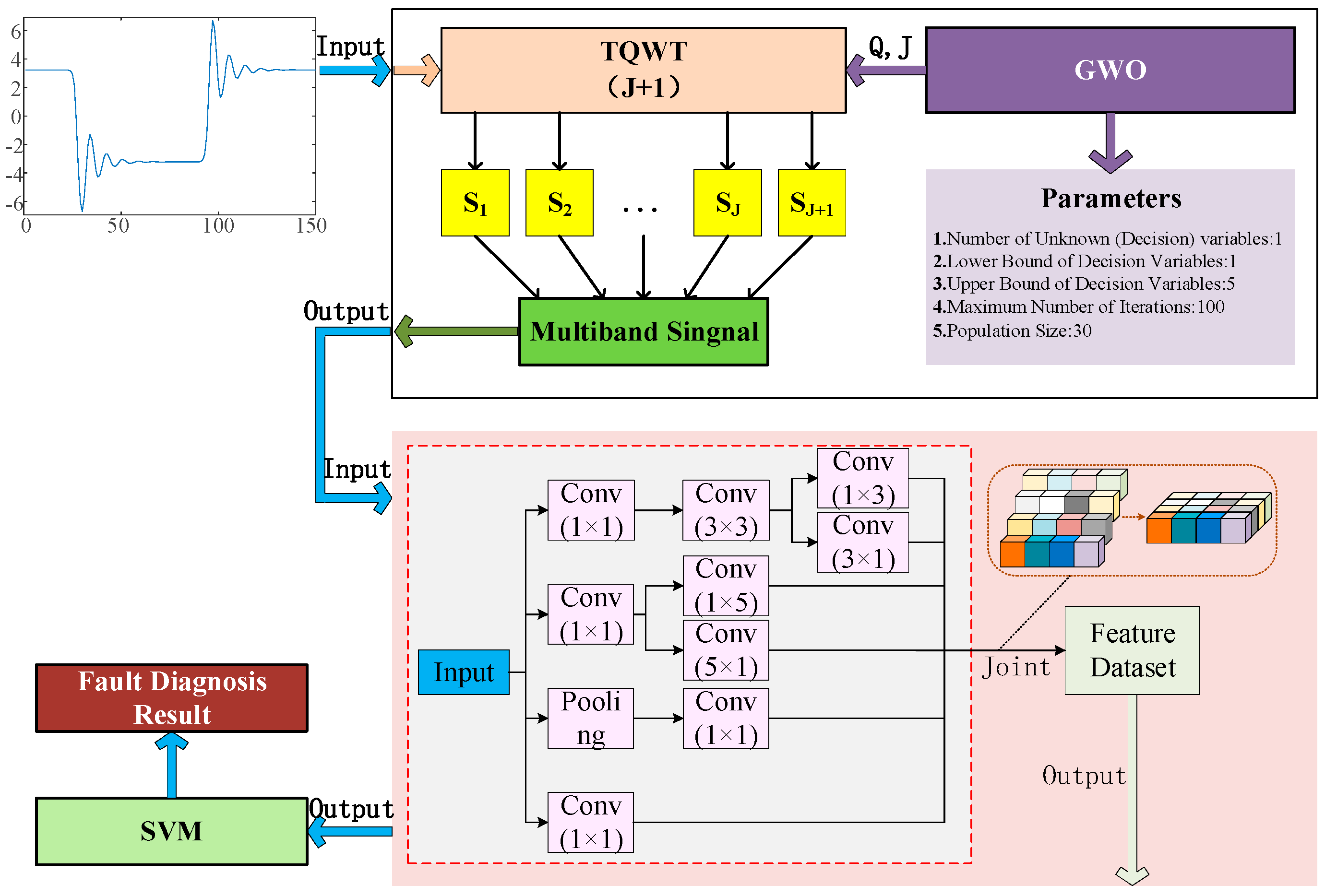

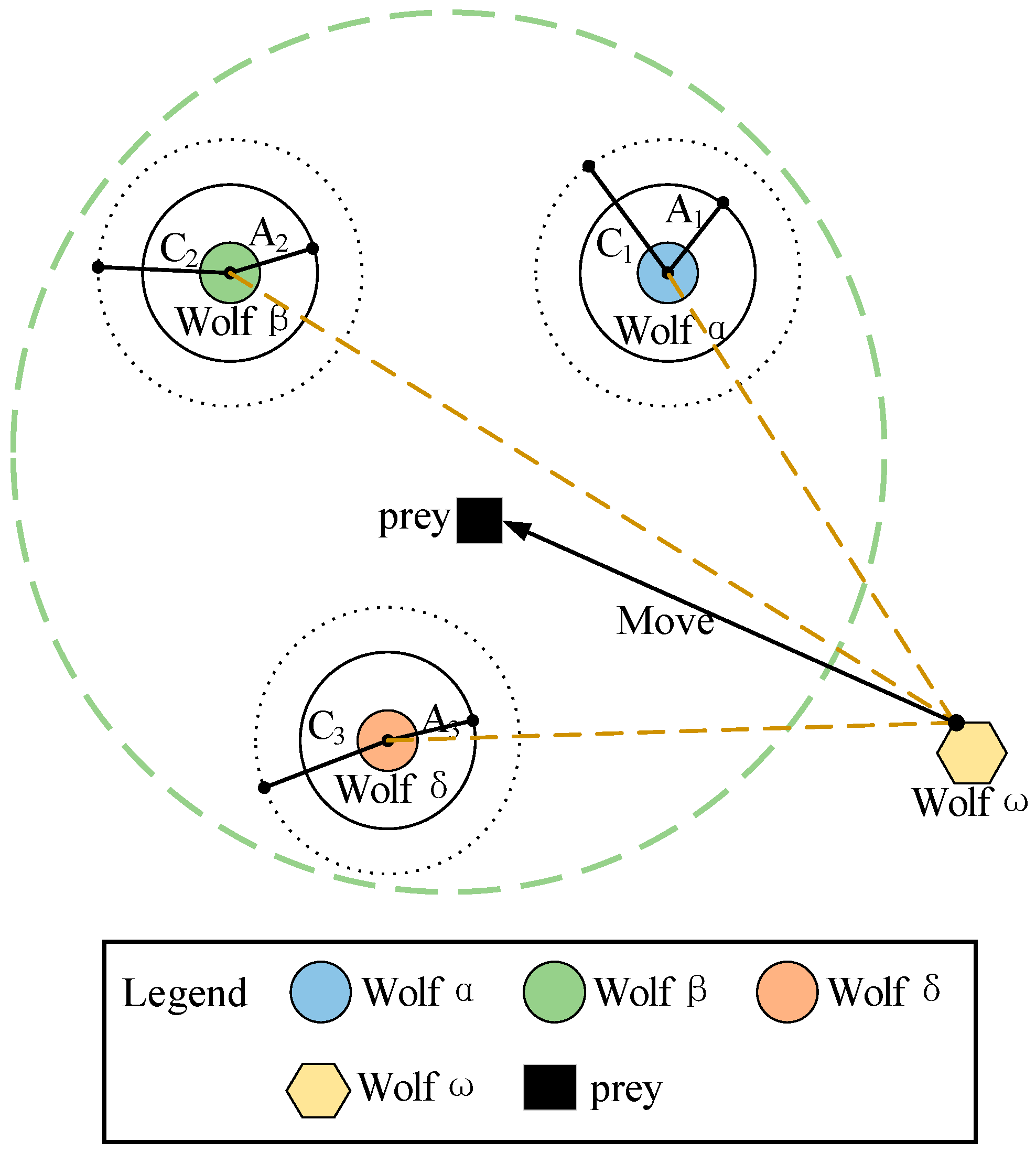
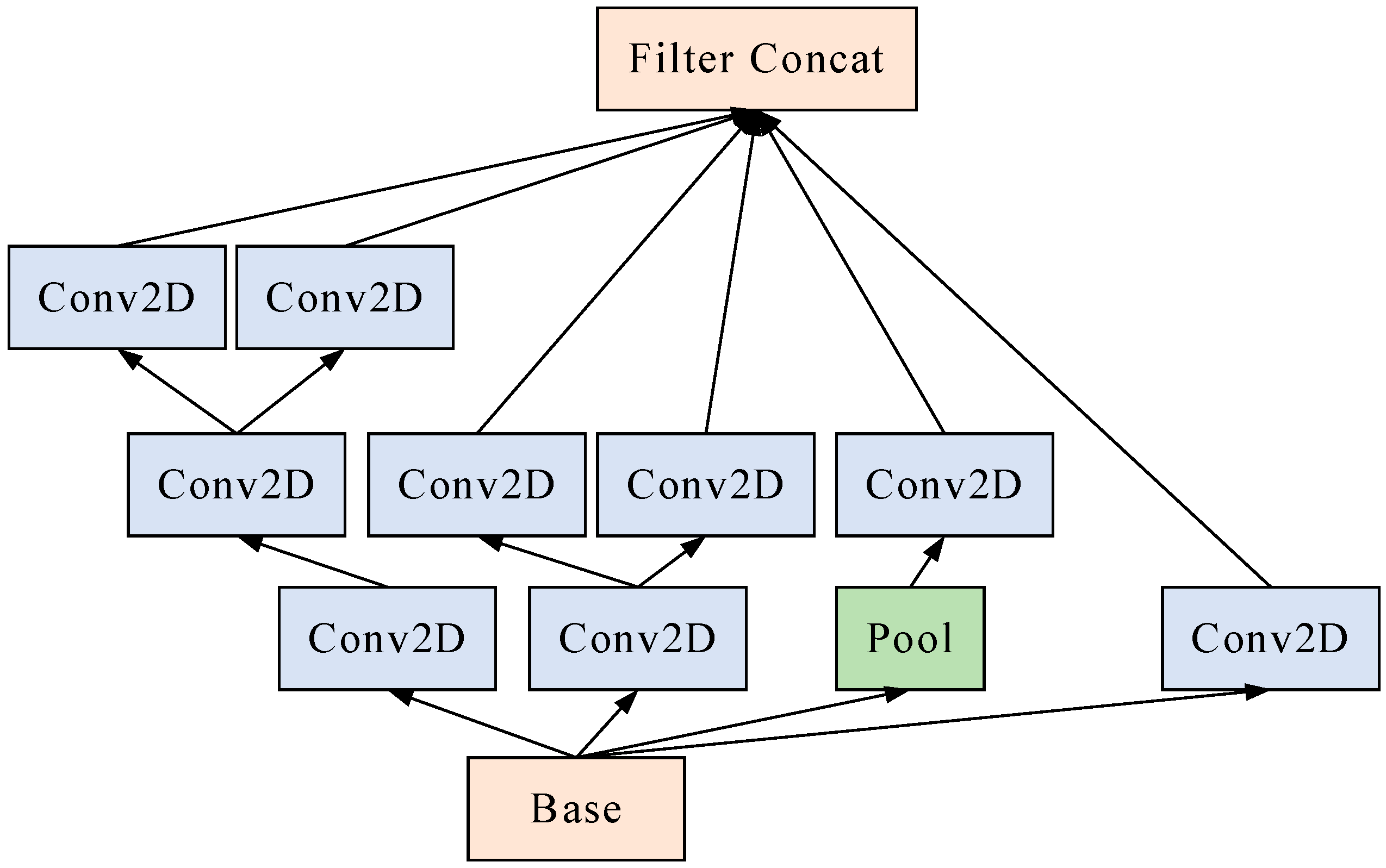
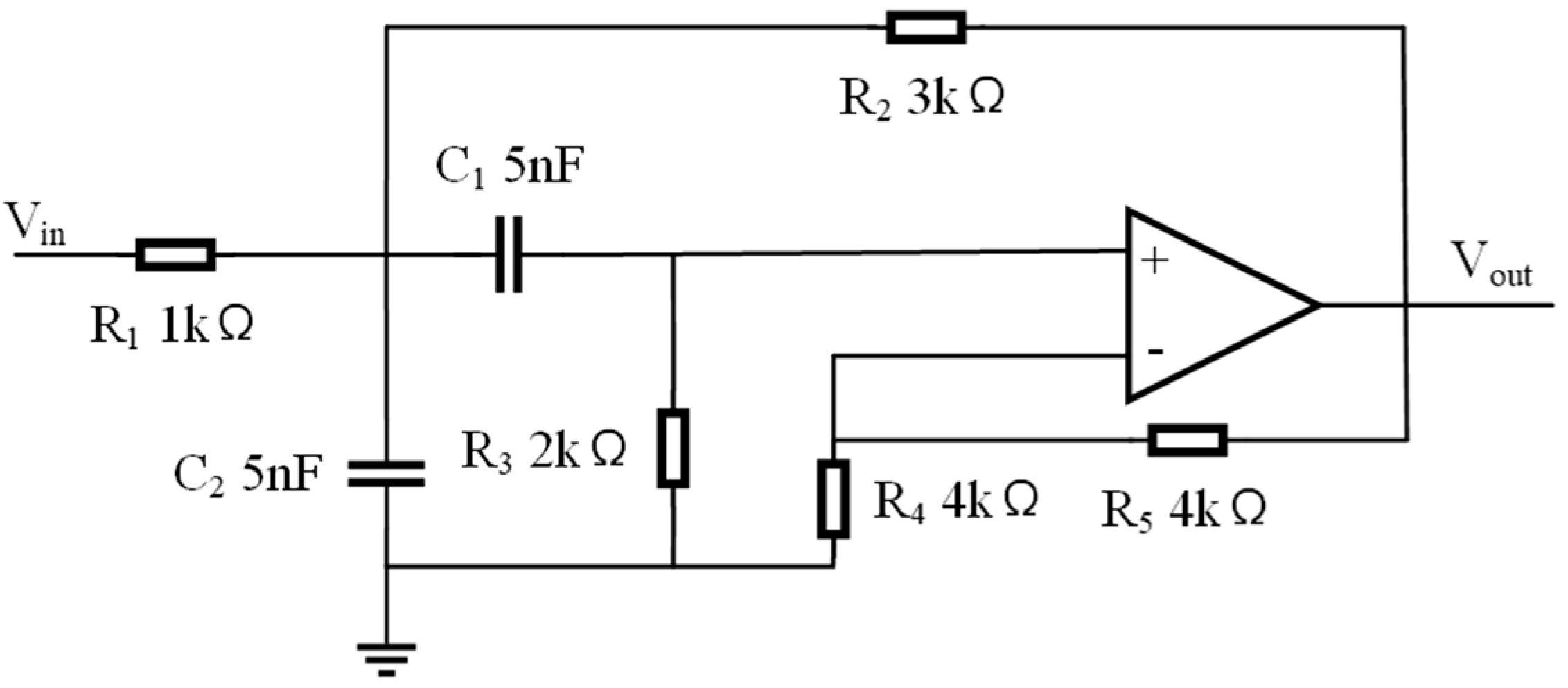
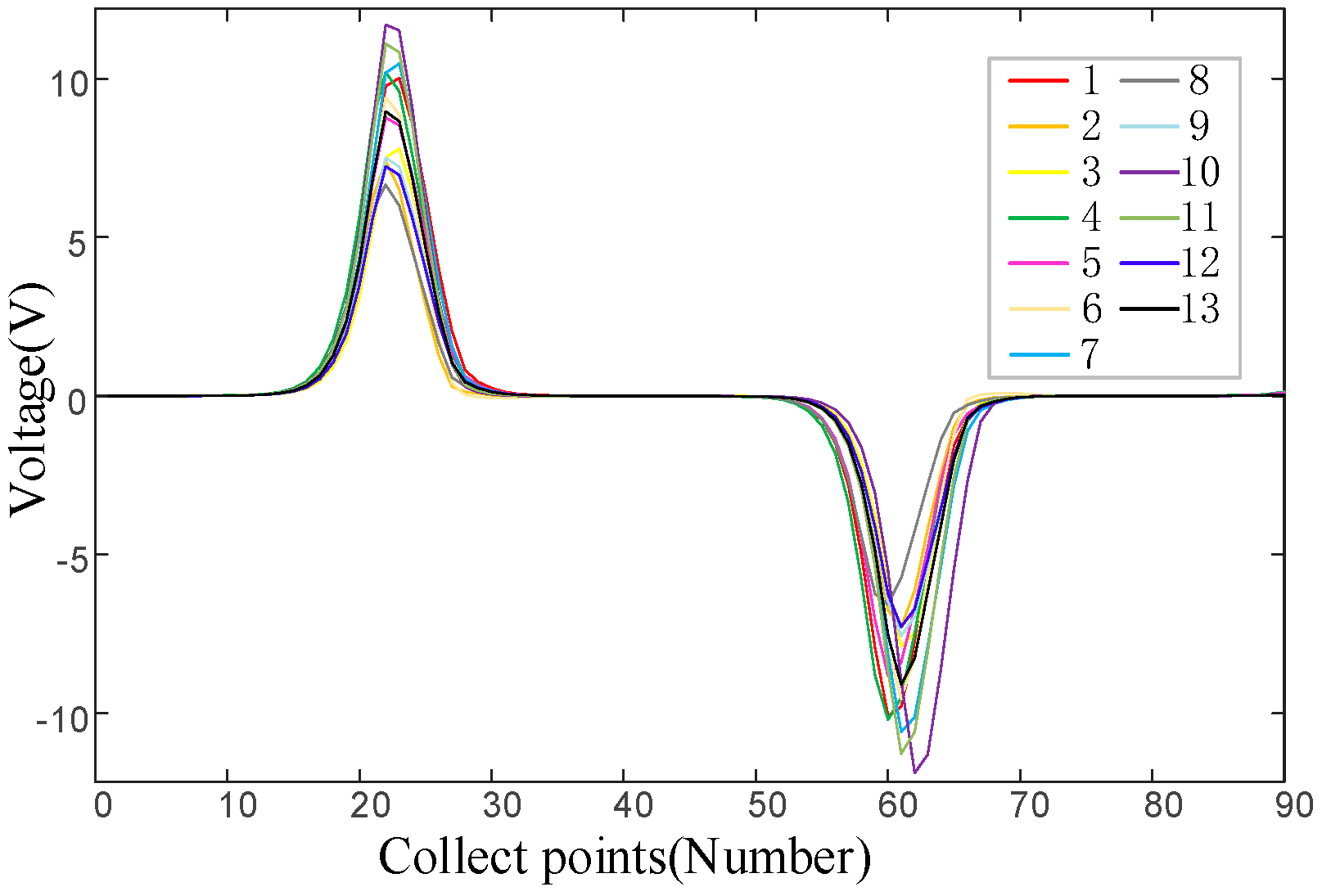
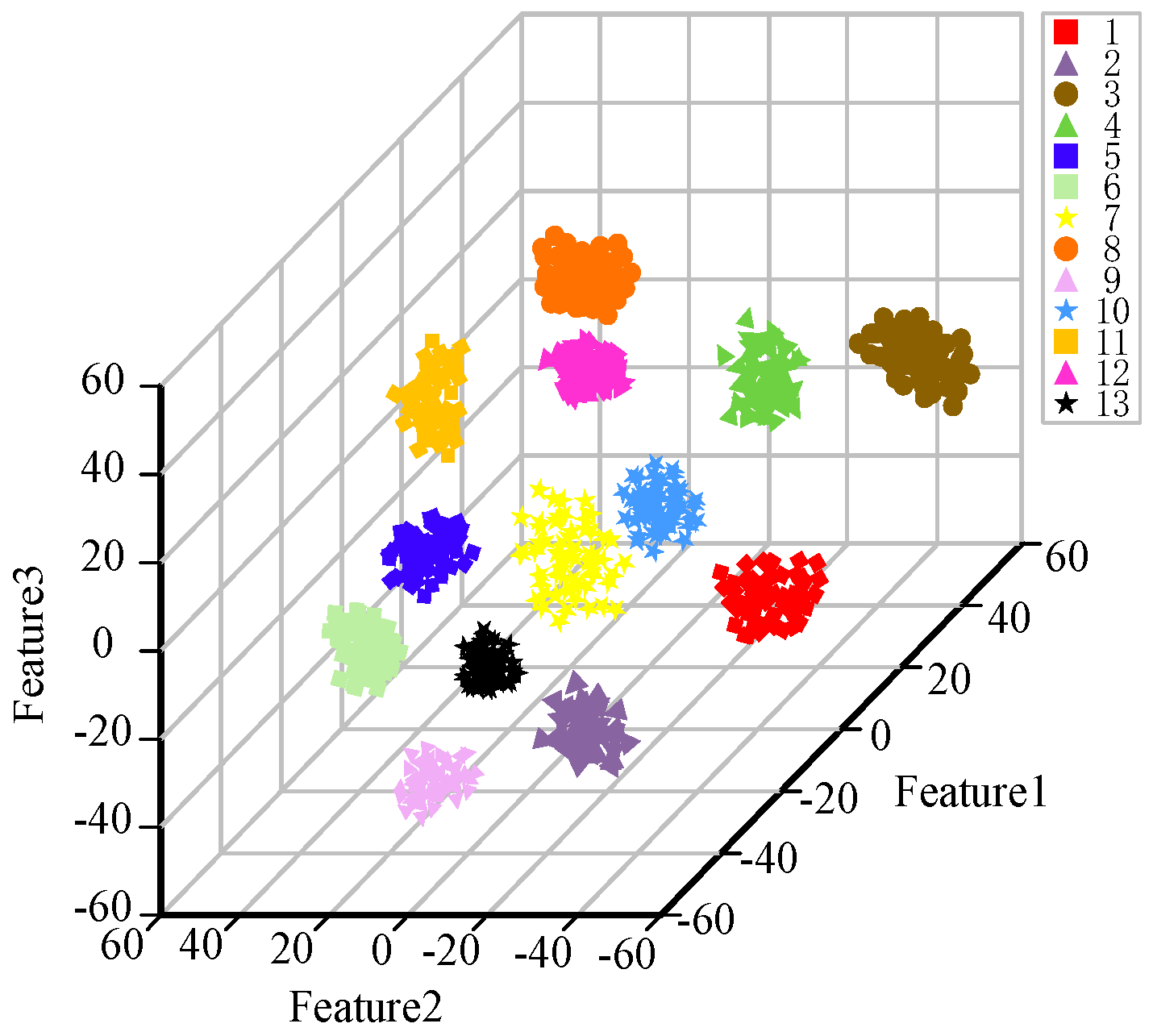
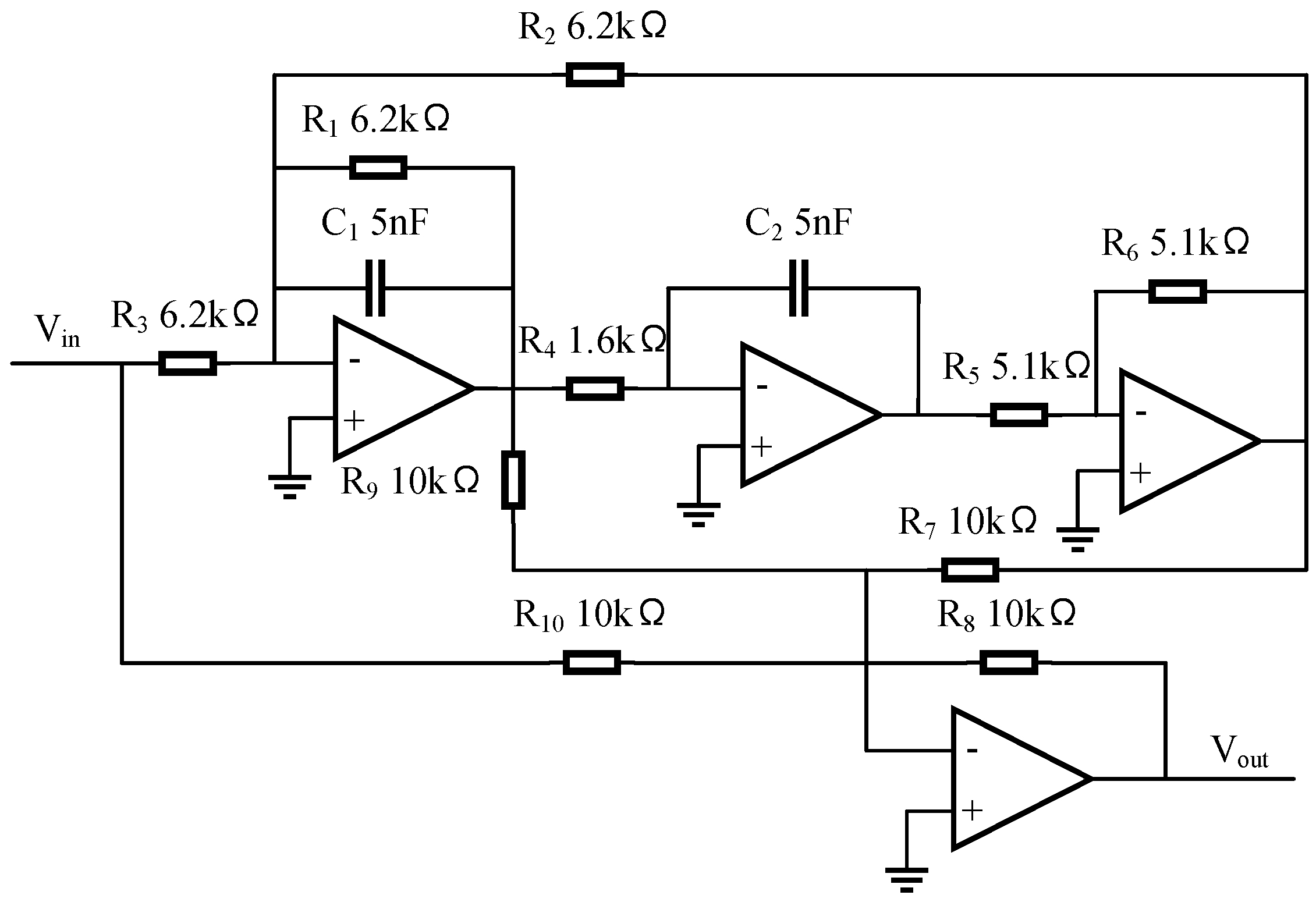
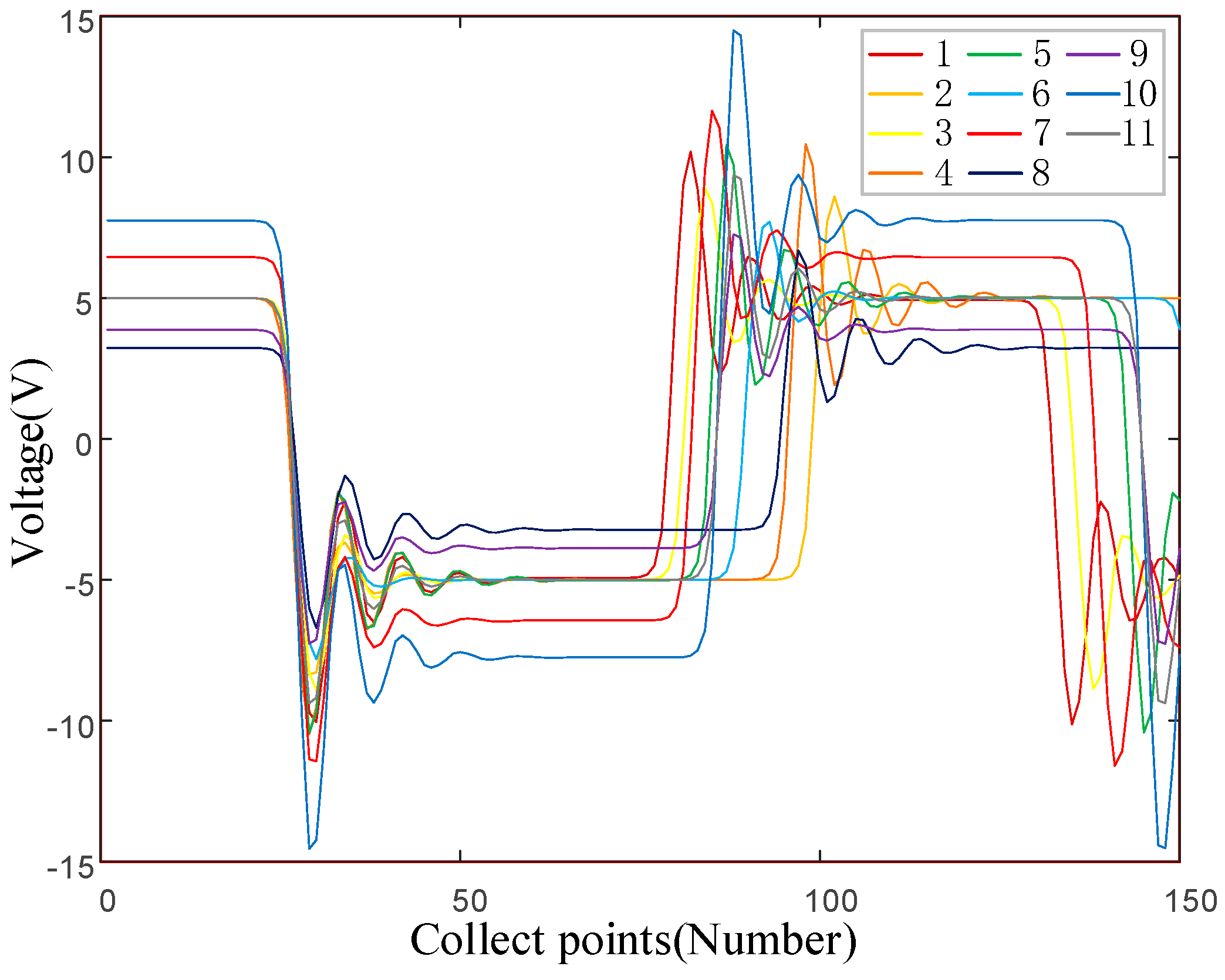


| Fault Type | Fault Label | Normal Value | Range of Fault |
|---|---|---|---|
| C1↑ | 1 | 5 nF | [6 nF, 7.5 nF] |
| C1↓ | 2 | 5 nF | [2.5 nF, 4 nF] |
| C2↑ | 3 | 5 nF | [6 nF, 7.5 nF] |
| C2↓ | 4 | 5 nF | [2.5 nF, 4 nF] |
| R2↑ | 5 | 3 KΩ | [3.6 kΩ, 4.5 kΩ] |
| R2↓ | 6 | 3 KΩ | [1.5 kΩ, 2.4 kΩ] |
| R3↑ | 7 | 2 KΩ | [2.4 kΩ, 3 kΩ] |
| R3↓ | 8 | 2 KΩ | [1 kΩ, 1.6 kΩ] |
| R4↑ | 9 | 4 KΩ | [4.8 kΩ, 6 kΩ] |
| R↓ | 10 | 4 KΩ | [2 kΩ, 3.2 kΩ] |
| R5↑ | 11 | 4 KΩ | [4.8 kΩ, 6 kΩ] |
| R5↓ | 12 | 4 KΩ | [2 kΩ, 3.2 kΩ] |
| NF | 13 | / | / |
| Fault Type | Fault Label | Normal Value | Range of Fault |
|---|---|---|---|
| C1↑ | 1 | 5 nF | [6 nF, 7.5 nF] |
| C1↓ | 2 | 5 nF | [2.5 nF, 4 nF] |
| C2↑ | 3 | 5 nF | [6 nF, 7.5 nF] |
| C2↓ | 4 | 5 nF | [2.5 nF, 4 nF] |
| R1↑ | 5 | 6.2 KΩ | [7.44 kΩ, 9.3 kΩ] |
| R1↓ | 6 | 6.2 KΩ | [3.1 kΩ, 4.96 kΩ] |
| R2↑ | 7 | 6.2 KΩ | [7.44 kΩ, 9.3 kΩ] |
| R2↓ | 8 | 6.2 KΩ | [3.1 kΩ, 4.96 kΩ] |
| R3↑ | 9 | 6.2 KΩ | [7.44 kΩ, 9.3 kΩ] |
| R3↓ | 10 | 6.2 KΩ | [3.1 kΩ, 4.96 kΩ] |
| NF | 13 | / | / |
| Circuits | Q = 3 | Search for Superior Q-Value |
|---|---|---|
| Case1 | 95.46% | 100% |
| Case2 | 96.59% | 99.09% |
| Layer | Parameters |
|---|---|
| Conv2D | filters = 128, Strides = (2,2), Kernel_size = (1,1) |
| Conv2D | filters = 128, Strides = (2,2), Kernel_size = (3,3) |
| Conv2D | filters = 64, Strides = (1,1), Kernel_size = (1,3) |
| Conv2D | filters = 64, Strides = (1,1), Kernel_size = (3,1) |
| Conv2D | filters = 256, Strides = (1,1), Kernel_size = (1,1) |
| Conv2D | filters = 64, Strides = (1,1), Kernel_size = (1,5) |
| Conv2D | filters = 64, Strides = (1,1), Kernel_size = (5,1) |
| MaxPooling2D | pool_size = (2,2), Strides = (2,2) |
| Conv2D | filters = 64, Strides = (1,1), Kernel_size = (1,1) |
| Conv2D | filters = 64, Strides = (1,1), Kernel_size = (1,1) |
Disclaimer/Publisher’s Note: The statements, opinions and data contained in all publications are solely those of the individual author(s) and contributor(s) and not of MDPI and/or the editor(s). MDPI and/or the editor(s) disclaim responsibility for any injury to people or property resulting from any ideas, methods, instructions or products referred to in the content. |
© 2024 by the authors. Licensee MDPI, Basel, Switzerland. This article is an open access article distributed under the terms and conditions of the Creative Commons Attribution (CC BY) license (https://creativecommons.org/licenses/by/4.0/).
Share and Cite
Yuan, X.; Yang, S.; Wang, W.; Sheng, Y.; Zhuang, X.; Yin, J. A Fault Diagnosis Method for Analog Circuits Based on Improved TQWT and Inception Model. Symmetry 2024, 16, 720. https://doi.org/10.3390/sym16060720
Yuan X, Yang S, Wang W, Sheng Y, Zhuang X, Yin J. A Fault Diagnosis Method for Analog Circuits Based on Improved TQWT and Inception Model. Symmetry. 2024; 16(6):720. https://doi.org/10.3390/sym16060720
Chicago/Turabian StyleYuan, Xinjia, Siting Yang, Wenmin Wang, Yunlong Sheng, Xuye Zhuang, and Jiancheng Yin. 2024. "A Fault Diagnosis Method for Analog Circuits Based on Improved TQWT and Inception Model" Symmetry 16, no. 6: 720. https://doi.org/10.3390/sym16060720





